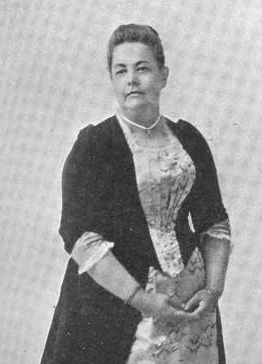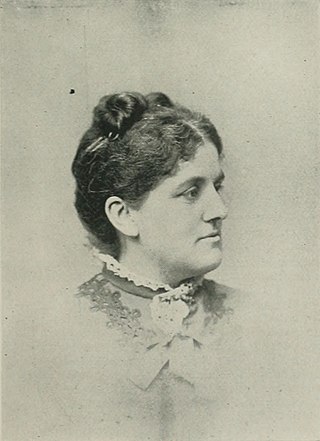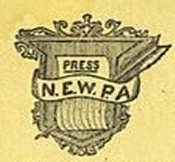
Mary Ashton Livermore was an American journalist, abolitionist, and advocate of women's rights. Her printed volumes included: Thirty Years Too Late, first published in 1847 as a prize temperance tale, and republished in 1878; Pen Pictures; or, Sketches from Domestic Life; What Shall We Do with Our Daughters? Superfluous Women, and Other Lectures; and My Story of the War. A Woman's Narrative of Four Years' Personal Experience as Nurse in the Union Army, and in Relief Work at Home, in Hospitals, Camps and at the Front during the War of the Rebellion. She wrote a sketch of the sculptor Anne Whitney for Women of the Day and delivered the historical address for the Centennial Celebration of the First Settlement of the Northwestern States in Marietta, Ohio on July 15, 1788.

Josephine St. Pierre Ruffin was a publisher, journalist, civil rights leader, suffragist, abolitionist, and editor of the Woman's Era, the first national newspaper published by and for African American women.

Anti-suffragism was a political movement composed of both men and women that began in the late 19th century in order to campaign against women's suffrage in countries such as Australia, Canada, Ireland, the United Kingdom and the United States. To some extent, Anti-suffragism was a Classical Conservative movement that sought to keep the status quo for women. More American women organized against their own right to vote than in favor of it, until 1916. Anti-suffragism was associated with "domestic feminism," the belief that women had the right to complete freedom within the home. In the United States, these activists were often referred to as "remonstrants" or "antis."

In journalism, the society page of a newspaper is largely or entirely devoted to the social and cultural events and gossip of the location covered. Other features that frequently appear on the society page are a calendar of charity events and pictures of locally, nationally and internationally famous people. Society pages expanded to become women's page sections.
The Illinois Woman's Press Association (IWPA) is an Illinois-based organization of professional women and men pursuing careers across the communications spectrum. It was founded in 1885 by a group of 47 women who saw a need for communication and support between women writers. The organization was incorporated on June 26, 1907.

Florida Ruffin Ridley was an African-American civil rights activist, suffragist, teacher, writer, and editor from Boston, Massachusetts. She was one of the first black public schoolteachers in Boston, and edited The Woman's Era, the country's first newspaper published by and for African-American women.

Martha Louise Rayne (1836–1911) was an American who was an early woman journalist. In addition to writing and editing several journals, she serialized short stories and poems in newspapers such as the Chicago Tribune, the Detroit Free Press, and the Los Angeles Herald. In addition to newspaper work, she published a guidebook of Chicago, etiquette books, and several novels. In 1886, she founded what may have been the first women's journalism school in the United States and four years later became a founding member and first vice president of the Michigan Woman's Press Association. Rayne was posthumously inducted into the Michigan Journalism Hall of Fame in 1998 and the Michigan Women's Hall of Fame in 2002.

Lillian A. Lewis was the first African American woman journalist in Boston, Massachusetts. She started her career in the 1880s with the Boston Advocate, a Black community newspaper, and began writing for the Boston Herald in the 1890s. To disguise her gender, she used the pen name "Bert Islew."

Sallie Joy White (1847-1909) was an American journalist. In 1870 she became the first woman staff reporter on a Boston newspaper when she was hired by the Boston Post, and she continued to write for local newspapers until her death in 1909. She co-founded the New England Woman's Press Association, and was an officer in several national press groups.

Kate Tannatt Woods (1838–1910) was an American author, editor, journalist, and clubwoman. She published a number of children's books and novels, and her poems, short stories, and articles were published widely in newspapers and magazines. She was the founder and first president of the Thought and Work Club of Salem, Massachusetts.

Marion A. McBride, also spelled MacBride, was an American journalist and clubwoman. She founded several women's press associations, most notably the New England Woman's Press Association. She wrote and lectured on domestic science, and was active in charitable causes and local politics. It was largely due to McBride's activism that the state of Massachusetts began hiring matrons for city police stations and built a separate facility for female inmates in Boston.
The National Woman's Press Association (1884-?), or NWPA, was an American professional association for women journalists.

Estelle M. H. Merrill was an American journalist and editor of the long nineteenth century. She lectured on various subjects, especially on educational and sociological questions, and was well-known as a leader and speaker in the club world. Merrill was a charter member of the New England Woman's Press Association and was the editor of the New England Kitchen Magazine.

Florence Breed Khan was an American political hostess and Bahá'i convert from Boston, wife of Mirza Ali Kuli Khan, a Persian translator and diplomat.

Harriette R. Shattuck was an American author, parliamentarian, teacher of parliamentary law, and pioneer suffragist. Shattuck served as assistant clerk of the Massachusetts House of Representatives in 1872, being the first woman to hold such a position. She wrote several books, including The Story of Dante's Divine Comedy (1887), Our Mutual Friend: A Comedy in Four Acts, Dramatized from Charles Dickens (1880), The "national" Method (1880), Marriage, Its Dangers and Duties (1882), Little Folks East and West (1891), Woman's Manual of Parliamentary Law (1891), The Woman's Manuel of Parliamentary Law (1895), Shattuck's Advanced Rules for Large Assemblies (1898), Our Mutual Friend: A Comedy, in Four Acts (1909), and Shattuck's Parliamentary Answers, Alphabetically Arranged (1915).

Maria I. Johnston was an American author, journalist, editor and lecturer. She wrote many stories, long and short. In her stories, she dealt for the most part with life in the West and South, the conditions caused by war and slavery being considered. She was the author of The Siege of Vicksburg, The Freedwoman, Jane, Hector, Oh, Come with Me to the West, Love, Miss Emily's Glove, Ante-Bellum, and The Story of a Confederate Colonel. Johnston was active with newspaper work and was identified with newspapers in St. Louis, New Orleans, Vicksburg, and Memphis. At times, she wrote under the nom de plumes of "Paul Pry" and "Neal Caxton". She was advocate of and writer for woman suffrage.












